Breathtaking Bluebells
April 3, 2009 by admin
Filed under Shade Gardening, Spring Bloomers, Spring Ephemerals
Virginia bluebells (Mertensia virginica) are nothing less than the royalty of spring ephemerals. Large, showy, and colorful, they put on one of the very best spectacles of any spring blooming plant, with all the rich costuming you’d expect in the court of a queen.
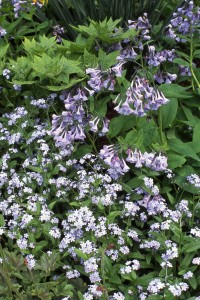
A May mêlée of Virginia bluebells and forget-me-nots
Virginia bluebells break ground very early in spring. Their tightly furled leaves look like tiny burgundy cabbages when they first emerge, but as they grow they quickly morph into medium green, fleshy oblongs that resemble the leafy green vegetable sorrel. Seemingly in no time they produce profuse clusters of dangling blue bell-shaped flowers on 18″ stems, blooming for several weeks in May. (They also come in a white-flowered form that is uncommon but possible to find.) Once flowering ceases, and almost before you have time to notice, they close up shop. Their leaves yellow rapidly, and the plants have gone completely dormant by mid June. They’ll spend the remainder of the year as inscrutable, seemingly dead but really just dormant roots nestled just below the soil surface. Incredibly, their entire aboveground life cycle is barely two months long.
The sheer rapidity of their growth and “demise” along with their large size and showiness make Virginia bluebells very border friendly. Their leaves do not need to hang around the garden for months to store enough energy to ensure flowering the following year. They put on their spectacular display and then vanish—a gardener’s dream!
Virginia bluebells are excellent interplanted with other blue-flowering plants such as perennial woodland phlox (Phlox divaricata). This phlox flowers just as the bluebells fade, so the segue from one to the other is seamless, and because the phlox spreads into a non-competitive groundcover, the bluebells will continue to arise through the mat of phlox foliage year after year. Biennial forget-me-not (Myosotis sylvatica) also makes a great companion, as shown in the photo above.
Virginia bluebells’ sky blue flowers are also an effective counterpoint to yellow daffodils. Gardeners with borders in both sun and shade can take best advantage of this artful duo, planting the sunny areas with clumps of daffodils and the shady ones with masses of bluebells. The result will be breathtaking!
Another natural companion is old-fashioned bleeding heart, whose brilliant pink or clean white flowers reach their peak simultaneously with those of Virginia bluebells, although the latter plant will go dormant months before the former. If you try this combination, use hostas, ferns or other late-emerging plants to fill in the areas occupied by the bluebells in May.
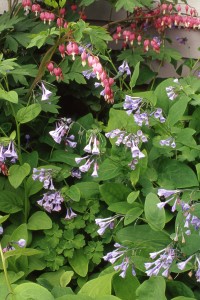
Bluebells and bleeding heart make a natural garden combination
Virginia bluebells spread readily by seed, moving outward from an original planting at a speed of a foot or two a year. In autumn, be careful working in the parts of your garden where bluebells are established, since it is so easy to dig into and accidentally destroy dormant roots at that time of year.
It’s not too late to have Virginia bluebells this year. Nurseries often stock them in April and early May since they’re one of the few plants that can be sold in full bloom at such a chilly time of year.
Sun/Shade needs: Half sun to moderately deep shade; full sun with adequate moisture
Hardiness: Zone 3
Size: 12-18″ tall; 8″ wide
Native status: Native to most of eastern North America, but not all of New England
Bloom times and other life cycle stats are accurate for northwest Connecticut. In milder areas all aspects of a plant’s life cycle may occur earlier in the year, and in colder areas, later.
March, 2010: Update! The good folks at GardenSMART took a shine to this article and reprinted it at their website. You’ll find this post (and many other interesting items) in the Articles section.
Signs of Spring
March 25, 2009 by admin
Filed under Shade Gardening, Spring, Spring Bloomers, Techniques
At 7:44 AM on March 20 the Sun crossed the celestial equator heading north. In common parlance, that translates to: spring is here!
It didn’t take long for wildlife to answer the call. Two days later, I awoke to the sound of a red-breasted robin singing at 6:00 AM. The cardinals have been getting redder and redder and going great gangbusters for weeks with their impressions of distant car alarms, but they’re here year round. The robin was the first migrant I’d heard stretch its vocal cords this year.
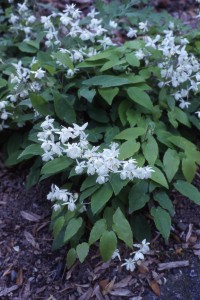
Epimedium x youngianum 'Niveum' in its April glory
While the robins celebrated spring by completing the last leg of their long journey, I was out in the garden performing one of the first jobs necessary to the season: uncovering my epimediums. (They have a common name—bishop’s hat—but somehow I just can’t bring myself to use it. They’ll always be epimediums to me.)
Along with hellebores and lungworts, epimediums start growing actively in March long before many of us have gotten out to remove the leaves that blew into the garden late last year after the rake had been put away for its long winter’s nap. (Or was it the gardener determined to nap? Tools can be convenient excuses…)
If you live on a lot with many trees, no matter how much you raked and blew last fall, you might find a lot of leaves staring up at you from the garden when the snow melts. Many plants can benefit from that cozy little coverlet, but for others it’s a problem.
While hellebores and lungworts are sturdy plants that can withstand the inevitable manhandling that occurs when you peel away sopping wet mats of oak leaves, epimediums are delicate little things with fragile stems all too easily snapped off. Wait even a week too long to clear them of leaf litter, and you may not be able to do it without surgical tools. (I exaggerate, but not by much.)
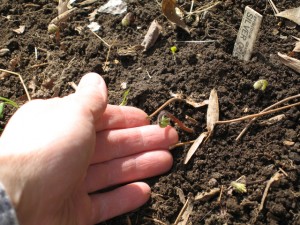
New epimedium growth under the leaf litter in March
At left is a picture of a curled epimedium flower stalk taken on March 20 just after being uncovered. This happens to be a patch of E. ‘Silver Queen’, a large-flowered white variety. In just a few weeks, it will put on a display to rival the extravagant bloomer E. x youngianum ‘Niveum’ shown in the picture above.
As careful as I tried to be when I removed the errant leaves, I wasn’t careful enough. Below left is a photograph of a stalk that I clumsily damaged. It takes almost no force to snap the top off these little guys, and that’s one spray of flowers less for me, the bees and everyone else this spring.
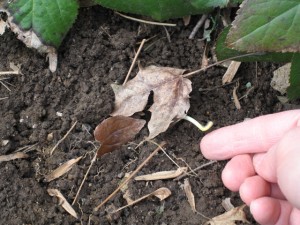
Epimedium stalk accidentally broken off
Some epimediums have fairly persistent stalks that don’t disintegrate on their own over winter. While you might not have to groom ‘Niveum’ at all, most others aren’t as accommodating. E. x perralchicum ‘Frohnleiten’ has perhaps the most evergreen leaves of any epimedium. This is both a plus and a minus. In snowless winters, they’re something to look at. But snow or no snow, in spring they’ll require cleanup. A pair of hedge clippers is the tool for this task. They do the job quickly and with all the precision required. You could just leave last year’s foliage alone, and new growth would come up through it and eventually conceal it, but most epimediums look better with a figurative shower and shave.
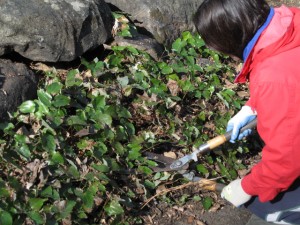
Shearing back epimediums in mid March
Unless you mulched last autumn, have some light, compost-based mulch handy to spread on your epimediums as soon as you uncover them. Otherwise, the soil around them will dry out quickly. At this time of year the sun is surprisingly intense, although most of us aren’t aware of it because air temperatures haven’t climbed yet. But I’ve learned that when I come out of my winter semi-hibernation and start working outdoors up to eight hours a day in March and April, I’d better wear sunscreen! New growth of shade-loving plants should also have some protection, not from the sun itself, but from the soil dryness it can cause.
Of course, even if I didn’t remove the leaves from my epimediums, they’d grow right up through their brown blanket and bloom anyway. But I prefer the look of a clean bed with a dressing of compost as a nice backdrop. Knowing that the job of removing those leaves without damaging the epimediums becomes harder with each passing day is enough incentive for me to get outside in mid March no matter what the weather. Ironically, as intolerant as they are of mishandling, fresh new epimedium growth will have no problem withstanding freezing nights.
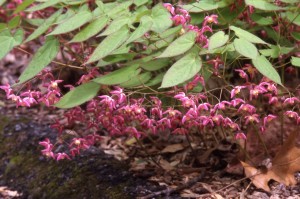
The reason for the work of the season. Darn—where'd that leaf come from?!
Spring!
Spring is just around the corner! Okay, not really, although according to the calendar the start of it is just two weeks away. For those of us in the North, the vernal equinox (that’s what will happen on March 20) is a purely conceptual start to spring. But the signs of the real thing are there, too, if you look. For one thing, the sugarhouses are steaming away, and “Pick up a gallon of medium amber” is on my To Do list. (Yes, I really go through a gallon of maple syrup each year. We’re having pancakes for dinner tonight.)
Outside, there are indicators that the change of seasons is under way. Just six days ago (Monday, March 2, 2009), we were blanketed by 15 inches of snow. Today, March 8, the only white stuff left is a few compacted inches in the shadow of trees and in the spots where the plows and snowblowers piled it up when the storm ended. For days, I’ve practically been able to see it melting.
This morning, with the thermometer reading a balmy 60°F (12°C), I went outside for the first of what will be many sessions picking up the detritus of winter (fallen tree branches, mainly) and pruning dead wood off various shrubs and trees. I took a moment to search for that most signal harbinger of spring: snowdrops (Galanthus spp.) As starkly obvious as little white and green flags against a sea of brown, they’re easy to pick out, even when they first emerge. What did I see? Nothing.
At 4:00 pm I went back outside to put my tools away, and my eyes were immediately drawn to several clumps of snowdrops pushing their way up into the light. Did they really shoulder aside the thick cover of last year’s fallen leaves in just a few hours? I wouldn’t be surprised. Spring is just around the corner.
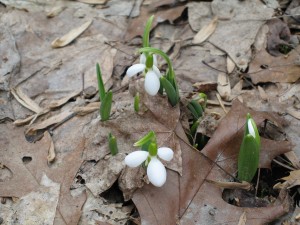
The first snowdrops of the year—March 8, 2009

